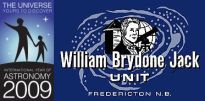You are here
Dobsonian
I will cover this in more detail under "Mounts/Altazimuth" but because the term has been used so frequently it deserves mention here as well. Dobsonian is typically meant to be - large aperature telescope 8 to 16+ inches - usually manual although there are options for Tracking and GoTo options - Reflection/Newtonian type of telescope (main and secondary mirror) Many Amature astronomers consider building one of these telescopes as they are the easiest to build (relatively speaking) and provide for years of enjoyment observing a variety of objects. You can purchase kits containing the mirrors and mounting gear only requiring you to purchase the plywood and typically using a sonotube (yes those cardboard tubes for concrete pillars for your deck).... and a lot of time and patience. Origin and design It is hard to classify the Dobsonian Telescope as a single invention. In the field of amateur telescope making most, if not all, of its design features had been used before. John Dobson, credited as having invented this design in the 1950s, points out that "for hundreds of years, wars were fought using cannon on 'Dobsonian' mounts". Dobson himself identified the characteristic features of the design as lightweight objective mirrors made of porthole glass, and mountings constructed from plywood, Teflon strips and other low-cost materials. Since he built these telescopes as aids in his avocation of instructional sidewalk astronomy, he prefers to call the design a "sidewalk telescope". It appears that John Dobson simply combined all these innovations in a design that is focused towards one goal: building a very large, inexpensive, easy to use, portable telescope for the sole purpose of visual observing of astronomical objects as a way to bring astronomy to the masses. Dobson's design innovations Dobson's design allows a builder with minimal skill to make an extremely large telescope out of common items. Dobson optimized the design for visual observation of faint objects such as star clusters, nebulae, and galaxies (what Amateur Astronomers call deep sky objects). These dim objects require a large objective mirror able to gather a large amount of light. Because "deep sky" observing often requires travel to dark locations away from city lights, the design benefits from being more compact, portable, and rugged than standard large Newtonian telescopes. John Dobson's telescopes combined several innovations to meet these criteria, including: - Thin mirrors: Instead of costly Pyrex mirror blanks with the standard 1:6 thickness ratios (1 cm thick for every 6 cm in diameter) so they won't flex and sag out of shape under their own weight, Dobson used mirrors made out of surplus glass ship porthole covers usually with 1:16 thickness ratios. Since the telescope design has an alt-azimuth mount the mirror only has to be supported in a simple cell with a backing of indoor/outdoor carpet to evenly support the weight of the much thinner mirror. - Construction tubes: Dobson replaced the traditional aluminum or fiberglass telescope tube with the thick compressed paper tubes used in construction to pour concrete columns. Sonotubes, the leading brand employed by Dobson, are less expensive than commercially available telescope tubes and are available in comparatively large sizes. Dobsonian scopes are intended to be transported out to dark sky locations, and Sonotubes are claimed to be more rugged than aluminum or fiberglass tubes which can dent or shatter from impacts. Sonotubes have the added advantage of being thermally stable and non-conductive which minimize unwanted convection currents in the light path caused by handling of the tube assembly. - A square "mirrorbox": Dobson used a plywood box for the tube base and mirror housing. This gave a rigid flat surface to attach the "carpet" support for the porthole mirrors he was using, and made it easy to attach the altitude bearings. - A simple alt-azimuth mount: Dobson opted for a simple to build and use altazimuth mount. He used a “gun carriage type” design consisting of a flat platform ("ground board") on which sits a rotating box with semicircular depressions cut in the top for the altitude bearings ("rocker" or "rocker box"). All parts were made from plywood and other common materials. For the azimuth (side-to-side) motion Dobson used a combination of Teflon blocks turning on a flat Formica covered surface. For the altitude (up-and-down) motion, Dobson used a large diameter axle "closet flange" turning on Teflon bearing blocks attached to the altitude cutouts. Dobson's use of Teflon on all bearing surfaces and the large diameter of the bearings created a smooth action with a moderate amount of friction, so that a clamp mechanism is not necessary to prevent unintentional motion of the telescope.
